Israel Idf Sten Thompson Schmeisser Suomi Paratrooper Smg Manual Book 1948
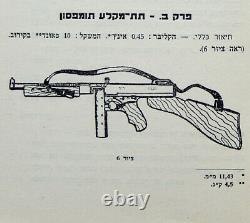
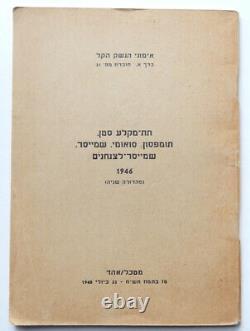
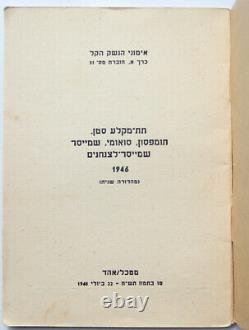
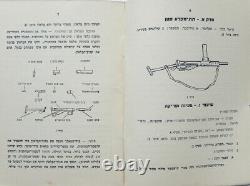
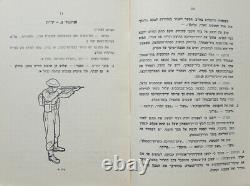

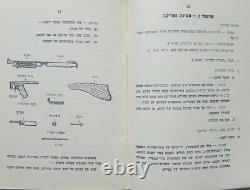

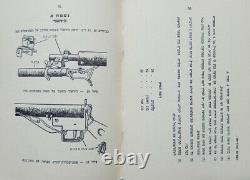
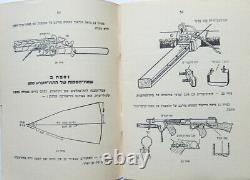


ISRAEL STEN THOMPSON SCHMEISSER SUOMI PARATROOPER SMG MANUAL BOOK 1948. Light Weapons Training manual- A very rare manual book that was issued by the Israeli Army Matkal- Training department July 23, 1948, printed by I. This book dedicated to train young Israeli army how to use, operate and shooting methode using sub machine gun devided to chapters by the weapons types; SMG Sten, SMG Thompson, SUOMI, Schmeiser and Schmeisser model for paratroopers. 54 pages with many diagrams. Please have a look at my other listings.
The MP 40 (Maschinenpistole 40) is a submachine gun chambered for the 9×19mm Parabellum cartridge. It was developed in Nazi Germany and used extensively by the Axis powers during World War II. Designed in 1938 by Heinrich Vollmer with inspiration from its predecessor the MP 38, it was heavily used by infantrymen (particularly platoon and squad leaders), and by paratroopers, on the Eastern and Western Fronts. Its advanced and modern features made it a favorite among soldiers and popular in countries from various parts of the world after the war.
It was often called "Schmeisser" by the Allies, after Hugo Schmeisser, who designed the MP 18, although he was not involved in the design or production of the MP40. The weapon's other variants included the MP 40/I and the MP 41. From 1940 to 1945, an estimated 1.1 million were produced by Erma Werke. The Maschinenpistole 40 ("Machine pistol 40") descended from its predecessor the MP 38, which was in turn based on the MP 36, a prototype made of machined steel.
[5] The MP 36 was developed independently by Erma Werke's Berthold Geipel with funding from the German Army. It took design elements from Heinrich Vollmer's VPM 1930 and EMP. Vollmer then worked on Berthold Geipel's MP 36 and in 1938 submitted a prototype to answer a request from the Heereswaffenamt (Army Weapons Office) for a new submachine gun, which was adopted as MP 38.
The MP 38 was a simplification of the MP 36, and the MP 40 was a further simplification of the MP 38, with certain cost-saving alterations, most notably in the more extensive use of stamped steel rather than machined parts. [5] The MP 40 was often called the "Schmeisser" by the Allies, after the weapon designer Hugo Schmeisser. Schmeisser had designed the MP 18, which was the first mass-produced submachine gun. He did not, however, have anything to do with the design or development of the MP 40, although he held a patent on the magazine. [6] The MP 40 submachine guns are open-bolt, blowback-operated automatic arms.The only mode of fire was fully automatic, but the relatively low rate of fire enabled single shots with controlled trigger pulls. [7] The bolt features a telescoping return spring guide which serves as a pneumatic recoil buffer.
[7] The cocking handle was permanently attached to the bolt on early MP 38s, but on late production MP 38s and MP 40s, the bolt handle was made as a separate part. [8] It also served as a safety by pushing the head of the handle into one of two separate notches above the main opening; this action locked the bolt either in the cocked (rear) or uncocked (forward) position. [8] The absence of this feature on early MP 38s resulted in field expedients such as leather harnesses with a small loop that were used to hold the bolt in the forward position. [9] The MP 38 receiver was made of machined steel, but this was a time-consuming and expensive process. [10] To save time and materials, and thus increase production, construction of the MP 40 receiver was simplified by using stamped steel and electro-spot welding as much as possible.[10] The MP 38 also features longitudinal grooving on the receiver and bolt, as well as a circular opening on the magazine housing. These features were eliminated on the MP 40. [10]One unique feature found on most MP 38 and MP 40 submachine guns was an aluminum, steel, or bakelite resting bar or support under the barrel. This was used to steady the weapon when firing over the side of open-top armored personnel carriers such as the Sd. A handguard, made of a synthetic material derived from bakelite, was located between the magazine housing and the pistol grip.
[11] The barrel lacked any form of insulation, which often resulted in burns on the supporting hand if it was incorrectly positioned. [11] The MP 40 also had a forward-folding metal stock, the first for a submachine gun, resulting in a shorter overall weapon when folded.
[12] However, this stock design was at times insufficiently durable for hard combat use. [12] Although the MP 40 was generally reliable, a major weakness was its 32-round magazine. [13] Unlike the double-column, staggered-feed magazine insert found on the Thompson M1921/1928 variants, the MP 40 used a double-column, single-feed insert. [13] The single-feed insert resulted in increased friction against the remaining cartridges moving upwards towards the feed lips, occasionally resulting in feed failures; this problem was exacerbated by the presence of dirt or other debris. [13] Another problem was that the magazine was also sometimes misused as a handhold.
[14] This could cause the weapon to malfunction when hand pressure on the magazine body caused the magazine lips to move out of the line of feed, since the magazine well did not keep the magazine firmly locked. [14] German soldiers were trained to grasp either the handhold on the underside of the weapon or the magazine housing with the supporting hand to avoid feed malfunctions. [14] Usage At the outbreak of World War II, the majority of German soldiers carried either Karabiner 98k rifles or MP 40s, both of which were regarded as the standard weapons of choice for an infantryman. [15] However, later confrontations with Soviet troops such as the Battle of Stalingrad, where entire enemy units were armed with PPSh-41 submachine guns, the Germans found themselves out-gunned in short range urban combat which caused a shift in their tactics, and by the end of the war the MP 40 and its derivatives were being issued to entire assault platoons on a limited basis.
[16] Starting in 1943, the German military moved to replace both the Karabiner 98k rifle and MP 40 with the new, revolutionary StG 44. [16][15] By the end of World War II in 1945, an estimated 1.1 million MP 40s had been produced of all variants. [17] Post-war usage During and after the end of World War II, many MP 40s were captured or surrendered (upwards of 200,000) to the Allies and were then redistributed to the paramilitary and irregular forces of some developing countries. [18] The Norwegian army withdrew the MP 38 from use in 1975 but used the MP 40 for some years more.
In particular, the Territorials (Heimevernet) used it until about 1990, when it was replaced by the Heckler & Koch MP5. [9] The MP 40/I (sometimes erroneously called MP 40/II) was a modified version of the standard MP 40 with a dual side-by-side magazine holder (for a theoretical ammunition total of 64 rounds), designed for special operations troops on the Eastern Front to compensate for the enemies' PPSh-41 larger magazine capacity. However, the design proved unsuccessful due to weight and reliability issues.
Authentic versions, in addition to the dual mag magazine well, also have a smaller buttpad and shortened ejector. [19] MP 41 An MP 41 with wooden stock In 1941, Hugo Schmeisser designed the MP 41, which was, in reality, an MP 40 upper receiver with a lower receiver of an MP 28 submachine gun. It saw limited service, however, and was issued only to SS and police units in 1944. The MP 41 was also supplied to Germany's Axis ally Romania.[20] Later in 1941, rival company Erma Werke sued Haenel, at which Schmeisser was Chief Designer, for patent infringement. Production subsequently ceased on the MP41. [21][22] Operators Simone Segouin, a French partisan, posing with an MP 40 in 1944 During World War II, the resistance and the Allies sometimes captured MP 40s to replace or supplement their own weapons. [23][24][25] The MP 40 was used for several decades following World War II by many countries around the world in armed conflicts.
Some found their way into guerrilla groups such as the Viet Cong or African guerrillas The Thompson submachine gun is an American submachine gun first invented by John T. Thompson in 1918 during World War I that became infamous during the Prohibition era, being a signature weapon of various organized crime syndicates in the United States. It was a common sight in the media of the time, being used by both law enforcement officers and criminals. [17] The Thompson submachine gun was also known informally as the "Tommy Gun", "Street Sweeper", "Annihilator", "Chicago Typewriter", "Trench Broom", "Chicago Submachine", "Chicago Piano", "Chicago Style", "Chicago Organ Grinder", "Drum Gun", "the Chopper", "the Tommy Boy" or simply "the Thompson".
[18][19][20][21][22] The Thompson was favored by soldiers, criminals, police, the FBI, and civilians alike for its fully automatic fire, while still being relatively lightweight, portable and easy to use. It has since gained popularity among civilian collectors for its historical significance. It has considerable significance in popular culture, especially in works about the Prohibition era and World War II, and is one of the most well known and recognised firearms in history. The original fully automatic Thompsons are no longer produced, but numerous semi-automatic civilian versions are still being manufactured by Auto-Ordnance. These retain a similar appearance to the original models, but they have various modifications in order to comply with US firearm laws.
Thompson developed the Thompson Submachine Gun. He originally envisioned an automatic rifle to replace the bolt action service rifles then in use, such as the American M1903 Springfield, but he came across a patent issued to John Bell Blish in 1915 while searching for a way to allow his weapon to operate safely without the complexity of a recoil or gas-operated reloading mechanism. Blish's design was based on the adhesion of inclined metal surfaces under pressure. [23] Thompson gained financial backing from Thomas F.
Ryan and started the Auto-Ordnance Company in 1916 for the purpose of developing his "auto rifle". It was primarily developed in Cleveland, Ohio, [24] and the principal designers were Theodore H.By late 1917, the limits of the Blish Principle were discovered; rather than working as a locked breech, it functioned as a friction-delayed blowback action. It was found that the only cartridge currently in service that was suitable for use with the lock was the.
Thompson then envisioned a "one-man, hand-held machine gun" in. 45 ACP as a "trench broom" for use in the ongoing trench warfare of World War I. Payne designed the gun and its stick and drum magazines. [25] At an Auto-Ordnance board meeting in 1919 to discuss the marketing of the "Annihilator", with the war now over, the weapon was officially renamed the "Thompson Submachine Gun". While other weapons had been developed shortly prior with similar objectives in mind, the Thompson was the first weapon to be labeled and marketed as a "submachine gun". [19] Thompson intended for the weapon to provide a high volume of automatic, man-portable fire for usage in trench warfare, a role for which the Browning Automatic Rifle (BAR) had been proven ill-suited. [26] This concept had already been developed by German troops using their own Bergmann MP 18, the world's first submachine gun, in concert with Sturmtruppen tactics. [27] The Thompson first entered production as the M1921. Federal sales were followed by sales to several police departments in the US and minor international sales to various armies and constabulary forces, chiefly in Central and South America. [31] The Marines used their Thompsons in the Banana Wars and in China. It was popular as a point-defense weapon for countering ambush by Nicaraguan guerrillas, and led to the organization of four-man fire teams with as much firepower as a nine-man rifle squad. The major complaints against the Thompson were its weight, inaccuracy at ranges over 50 yards (46 m), and the lack of penetrating power of the. [32] Some of the first batches of Thompsons were bought in America by agents of the Irish Republic, notably Harry Boland. The first test of a Thompson in Ireland was performed by West Cork Brigade commander Tom Barry in presence of IRA leader Michael Collins. The remainder made their way to the Irish Republican Army by way of Liverpool and were used in the last month of the Irish War of Independence (1919-21). [34] After a truce with the British in July 1921, the IRA imported more Thompsons and used them in the subsequent Irish Civil War (1922-23).They were not found to be very effective in Ireland; the Thompson caused serious casualties in only 32 percent of the actions in which it was used. [2] The Thompson achieved most of its early notoriety in the hands of Prohibition and Great Depression-era gangsters, the lawmen who pursued them, and in Hollywood films about their exploits, most notably in the St Valentine's Day Massacre. The two Thompson guns used in the massacre are still held by the Berrien County Sheriff's Department. [35] The Thompson has been referred to by one researcher as the "gun that made the twenties roar".
[36][37] In 1926, the Cutts Compensator (a muzzle brake) was offered as an option for the M1921; Thompsons with the compensator were cataloged as No. [25] In 1928, Federal Laboratories took over the distribution of the weapon from Thompson's Auto Ordnance Corporation. [38] A British soldier equipped with a Thompson M1928 submachine gun (drum magazine), November 25, 1940 Nationalist China acquired a quantity for use against Japanese land forces, and eventually began producing copies of the Thompson in small quantities for use by its armies and militias. In the 1930s, Taiyuan Arsenal produced copies of the Thompson for Yan Xishan, the warlord of Shanxi province. The FBI first acquired Thompsons in 1933 following the Kansas n 1938, the Thompson submachine gun was adopted by the U.
Military, serving during World War II and beyond. There were two military types of Thompson SMG. The M1928A1 had provisions for box and drum magazines. It had a Cutts compensator, cooling fins on the barrel, employed a delayed blowback action and its charging handle was on the top of the receiver.
The M1 and M1A1 had a barrel without cooling fins, a simplified rear sight, provisions only for box magazines, employed a straight blowback action and the charging handle was on the side of the receiver. Over 1.5 million military Thompson submachine guns were produced during World War II The staff of Savage Arms looked for ways to simplify the M1928A1, producing a prototype in February 1942 which was tested at Aberdeen Proving Ground in March 1942; Army Ordnance approved adoption as the M1 in April 1942.M1s were made by Savage Arms and by Auto-Ordnance. M1s were issued with the 30-round box magazine and would accept the earlier 20-round box, but would not accept the drum magazine.
Fires on a Japanese position using an M1 Thompson submachine gun during an advance on Okinawa in 1945. Combat use German Fallschirmjäger troops in Tunisia with a captured M1928A1 Thompson submachine gun The Thompson was used in World War II in the hands of Allied troops as a weapon for scouts, non-commissioned officers (corporal, sergeant, and higher), and patrol leaders, as well as commissioned officers, tank crewmen, and soldiers performing raids on German positions. In the European theater, the gun was widely utilized in British and Canadian commando units, as well as in the U.
Army paratrooper and Ranger battalions, where it was issued more frequently than in line infantry units because of its high rate of fire and its stopping power, which made it very effective in the kinds of close combat these special operations troops were expected to undertake. Military Police were fond of it, as were paratroopers, who "borrowed" Thompsons from members of mortar squads for use on patrols behind enemy lines. [43] The gun was prized by those lucky enough to get one and proved itself in the close street fighting that was encountered frequently during the invasion of France. A Swedish variant of the M1928A1, the Kulsprutepistol m/40 (submachine gun, model 40), served in the Swedish Army between 1940 and 1951.
Through Lend-Lease, the Soviet Union also received the Thompson, but due to a shortage of appropriate ammunition, its use was not widespread. [44] In the Malayan Campaign, the Burma Campaign and the Pacific Theater, Lend-Lease issue Thompsons were used by the British Army, Indian Army, Australian Army infantry and other Commonwealth forces. They used the Thompson extensively in jungle patrols and ambushes, where it was prized for its firepower, though it was criticized for its hefty weight and poor reliability. Difficulties in supply eventually led to its replacement in Australian Army units in 1943 by other submachine guns such as the Owen and Austen, and British forces also largely replaced it with the Sten gun.
Thompsons were also given to the Royal Australian Air Force and Royal Australian Navy. New Zealand commando forces initially used Thompsons but switched them for the more reliable, lighter, and more accurate Owen during the Solomon Islands and Guadalcanal campaigns. Marines also used the Thompson as a limited-issue weapon, especially during their later island assaults. The Thompson was soon found to have limited effect in heavy jungle cover, where the low-velocity. 45 bullet would not penetrate most small-diameter trees or protective armor vests.In 1923, the Army had rejected the. 45 Remington-Thompson, which had twice the energy of the.
Army, many Pacific War jungle patrols were originally equipped with Thompsons in the early phases of the New Guinea and Guadalcanal campaigns, but soon began employing the Browning Automatic Rifle in its place as a point defense weapon. [47] The Army introduced the U. M3 and M3A1 submachine guns in 1943 with plans to produce the latter in numbers sufficient to cancel future orders for the Thompson, while gradually withdrawing it from the first-line service. Though the M3 was considerably cheaper to produce, at the end of World War II, the Thompson, with a total wartime production of over 1.5 million, outnumbered the M3/M3A1 submachine guns in service by nearly three to one.Thompson submachine guns were used by both sides during the 1948 Arab-Israeli war. [48] Following the war, Thompsons were issued to members of Israel's elite Unit 101, upon the formation of that unit in 1953. [49] During the Greek Civil War, the Thompson submachine gun was used by both sides. The Hellenic Armed Forces, gendarmerie and police units were equipped with Thompson submachine guns supplied by the British and later in the war by the United States.
The opposing Communist fighters of the Democratic Army of Greece were also using Thompson submachine guns, either captured from government forces or inherited from ELAS. ELAS was the strongest of the resistance forces during the period of Greek Resistance against the Germans and Italians and were supplied with arms from both the British and the United States.
After the demobilization of ELAS, an unspecified number of arms were not surrendered to the government but kept hidden, and were later used by the Democratic Army of Greece. [50] The Thompson also found service with the KNIL and the Netherlands Marine Corps during their attempt to retake their former colony of Indonesia. [51] Captured examples were later used by Indonesian forces against Dutch forces[citation needed] and during by Indonesian infiltrators during the 1965 Indonesia-Malaysia confrontation. [52] A KNIL soldier armed with an M1928A1 submachine gun; c. 1948 By the time of the Korean War in 1950, the Thompson had seen much use by the U. And South Korean military, even though the Thompson had been replaced as standard-issue by the M3/M3A1. With huge numbers of guns available in army ordnance arsenals, the Thompson remained classed as Limited Standard or Substitute Standard long after the standardization of the M3/M3A1. During the Korean War, US troops were surprised to encounter communist Chinese troops armed with Thompsons (amongst other captured US-made Nationalist Chinese and American firearms), especially during unexpected night-time assaults which became a prominent Chinese combat tactic in the conflict. The gun's ability to deliver large quantities of short-range automatic assault fire proved very useful in both defense and assault during the early part of the war when it was constantly mobile and shifting back and forth.Many Chinese Thompsons were captured and placed into service with American soldiers and marines for the remaining period of the war. The Yugoslav Army received 34,000 M1A1 Thompsons during the 1950s as part of a US Military Aid to Yugoslavia Agreement. These guns were used during the Yugoslav Wars in the 1990s. [10] During the Cuban Revolution, the Thompson submachine gun was used by both Batista's army and Fidel Castro's guerrillas. Both the latter and the Brigade 2506 also used some during the bay of Pigs Invasion.
[53] During the Vietnam War, some South Vietnamese army units and defense militia were armed with Thompson submachine guns, and a few of these weapons were used by reconnaissance units, advisors, and other American troops. It was partially replaced by the MAC-10, albeit during Vietnam, the fully automatic fire provided by the M16 made the Thompson less effective than it previously had been. Still, not only did some U.
Soldiers have use of them in Vietnam, they encountered them as well. The Viet Cong liked the weapon and used both captured models as well as manufacturing their own copies in small jungle workshops. [54] The Australian government destroyed most of their Thompson machine carbines in the 1960s. They were then captured and used by the Khmer Rouge.
According to historian Peter Hart, The Thompson remained a key part of both the Official IRA and Provisional IRA arsenals until well into the 1970s when it was superseded by the Armalite and the AK-47. [9] The Thompson was also used by U.
And overseas law enforcement and police forces, most prominently by the FBI. The FBI used Thompsons until they were declared obsolete and ordered destroyed in the early 1970s. [55] Early versions of the Thompson, the Model 1919, had a fairly high cyclic rate of fire, as high as 1,200 rounds per minute (rpm), with most Model 1921s at 800 rpm.
Navy ordered 500 Thompsons but requested a lower rate of fire. Thompson requested Payne develop a method of reducing the cyclic rate of fire. Payne replaced the actuator with a heavier one and the recoil spring with a stiffer one; the changes reduced the rate of fire from 800 to the 600 rpm of the U. Later M1 and M1A1 Thompsons averaged also 600 rpm.
[58] This rate of fire, combined with a rather heavy trigger pull and a stock with an excessive drop, increases the tendency for the barrel to climb off target in automatic fire. [58][59] Compared to more modern submachine guns, the Thompson is quite heavy, weighing roughly the same as the contemporary M1 Garand semi-automatic rifle, and requires a lot of cleaning. This was one of the major complaints about the weapon by U. Army personnel to whom it was issued. [32] Thompson 1921, field stripped Although the drum magazine provided significant firepower, in military service it was found to be overly heavy and bulky, especially when slung on the shoulder while marching. [59] The M1928A1 Thompson drum magazine was rather fragile, and cartridges tended to rattle inside it, producing unwanted noise.[60] For these reasons, the 20-round and later 30-round box magazines soon proved most popular with military users of the M1928A1, and drum compatibility was not included in the design of the wartime M1 and M1A1 models. The Thompson was one of the earliest submachine guns to incorporate a double-column, staggered-feed box magazine design, which undoubtedly contributed to the gun's reputation for reliability.
In addition, the gun performed better than most after exposure to rain, dirt, and mud. [32] The selective-fire (semi or fully automatic) Thompson fires from the "open bolt" position, in which the bolt is held fully to rearward by the sear when cocked.
When the trigger is depressed, the bolt is released, traveling forward to chamber and simultaneously fire the first and subsequent rounds until either the trigger is released or the ammunition is exhausted. This eliminates the risk of "cook-off", which can sometimes occur in closed-bolt automatic weapons.Persuader and Annihilator There were two main experimental models of the Thompson. The Persuader was a belt-fed version developed in 1917/18.
It was partially built, but never completely finished. Ver 10 prototypes were similar in appearance to the later models, but without the rear sight and butt stock mounts. The Annihilator prototypes first were fed from a 20-round box magazine, but later, the 50- and 100-round drum magazine models were developed. Model 1919 Starting with the Serial no.11, the Model 1919 takes the final appearance of the later Thompsons with the rear sights and butt stock. The Model 1919 was limited to about 40 units; the first built did not use the drums, as it was too difficult to fire.
Many variations have been noted within this model. The weapons had very high cyclic rates up to 1,500 rpm. [17] This was the weapon Brigadier General Thompson demonstrated at Camp Perry in 1920.
A number of Model 1919s were made without butt stocks, rear and front sights, but the final version closely resembled the later Model 1921. This model was designed to "sweep" trenches with bullets.The New York City Police Department was the largest purchaser of the M1919. Some experimental calibers aside from the standard. 45 ACP (11.4x23mm) were the. 351 WSL variant Only one prototype was made in. 351 WSL using a standard 20 barrel which had a ROF of 1000rpm.
30 Carbine The layout and ergonomics of the Thompson submachine gun were also considered for the role of a Light Rifle before the adoption of the M1 Carbine. It was based on the M1921/27 variants. However, it was turned down without testing due to logistical problems. 30-06 variant was intended as a rival to the M1918 BAR. It had an extended receiver with a recoil buffer and fed from 20 round magazines. [62] Production Model 1921 Colt address on Thompson 1921 SMG The "Anti-Bandit Gun":1920s advertisement of the Thompson M1921 for United States law enforcement forces Thompson Autorifle (top, upright) and SMG Model (bottom, inverted) of 1921 The Model 1921 (M1921) was the first major production model. Fifteen thousand were produced by Colt for Auto-Ordnance.In its original design, it was finished more like a sporting weapon, with an adjustable rear sight, a blued, finned barrel and vertical foregrip (or pistol grip) and the Blish lock. The M1921 was famous throughout its career with police and criminals and in motion pictures. This model gained fame from its use by criminals during Prohibition, and was nicknamed "tommy gun" by the media. [citation needed] Model 1923 The Model 1923 was a heavy submachine gun introduced to potentially expand the Auto-Ordnance product line and was demonstrated for the U.
[63] It fired the more powerful. 45 Remington-Thompson cartridge which fired a heavier 250 gr (0.57 oz; 16 g) bullet at muzzle velocities of about 1,450 ft/s (440 m/s) and energy about 1,170 ft·lb (1,590 J), with greater range than the.
It introduced a horizontal forearm, improved inline stock for accuracy, 14 in (36 cm) barrel, bipod, and bayonet lug. The M1923 was intended to rival the M1918 Browning Automatic Rifle (BAR), with which the Army was already satisfied. The Army did not give the Model 1923 much consideration, so it was not adopted.Model 1921AC (1926) While not a new model in the usual sense of incorporating major changes, in 1926 the Cutts Compensator (a muzzle brake) was offered as an option for the M1921; Thompsons with the compensator were cataloged as No. [25] The Model 1921 was thereafter referred to as Model 1921A or Model 1921AC, though some collectors still refer to it as the Model 1921. Model 1928 The Model 1928 was the first type widely used by military forces, with the U. Marine Corps as major buyers through the 1930s. The original Model 1928s were Model 1921s with weight added to the actuator, which slowed down the cyclic rate of fire, a United States Navy requirement.
On these guns, the model number "1921" on the receiver was updated by stamping an "8" over the last "1". The Navy Model 1928 has several names among collectors: the "Colt Overstamp", "1921 Overstamp", "28 Navy", or just "28N". The 1928 Thompson would be the last small arm adopted by the U. Army that used a year designation in the official nomenclature. A notable variant of the Model 1928 with an aluminum receiver and tenite grip, buttstock, and forend, was made by Savage.[64] M1928A1 M1928A1 at Fort Knox, Kentucky, June 1942 The M1928A1 variant entered mass production before the attack on Pearl Harbor, as on-hand stocks ran out. Changes included a horizontal forend, in place of the distinctive vertical foregrip ("pistol grip"), and a provision for a military sling. Though it could use both the 50-round drum and the 20- or 30-round box magazines, active service favored the box magazines as the drums were more prone to jamming, rattled when moving, and were too heavy and bulky on long patrols. Wartime production variants had a fixed rear sight without the triangular sight guard wings and a non-ribbed barrel, both like those found on the M1/M1A1.
In addition, the Soviet Union received M1928A1s, included as standard equipment with the M3 light tanks obtained through Lend-Lease. These submachine guns were used to a limited extent by the Red Army. [65] An M1928A1 with an unusual inline stock, modified with elevated sights to increase accuracy, also was produced. Some Thompsons were built with a folding stock, similar to M1A1 Carbines used by Allied tank crews, drivers and paratroopers and submarine raiders.
[66] The Suomi KP/-31 (Suomi-konepistooli or "Finland-submachine gun", literally: "Finland Machine-pistol") is a submachine gun (SMG) of Finnish design that was mainly used during World War II. It is a descendant of the M-22 prototype and the KP/-26 production model, which was revealed to the public in 1925. The Suomi-konepistooli KP/-31 is often abbreviated to Suomi KP. The Suomi KP/-31 is regarded by many[6] as one of the most successful submachine guns of World War II. It also had a profound effect on that conflict beyond Finland as the Soviet authorities, who had been dismissive of submachine guns, were persuaded of their deadly efficiency by the Finns after attacking them in 1939.[7] Its 71-round drum magazine was later copied and adopted by the Soviets for their PPD-40 and PPSh-41. [8] Though a relatively early design, the Suomi was a formidable weapon: highly controllable [9] and with accuracy superior to that of the mass-produced PPSh-41 [8] thanks in part to a noticeably longer barrel, with the same exceptionally high rate of fire and an equally large magazine capacity. [8] Its one major disadvantage was its high production cost, which led to the later introduction of the KP/-44, a close copy of the Soviet PPS-43 but accepting the existing magazines and drums for the KP/-31. The M-22 and KP/-26 were made by Konepistooli Oy, founded by Master Armorer Aimo Lahti, Captain V. The Suomi KP/-31 was designed by Koskinen and Lahti.
The Suomi KP/-31 went into serial production in 1931 by Tikkakoski Oy and most of these weapons were bought by the Finnish Defence Forces. The Finnish Defence Forces were equipped with about 4000 Suomi KP/-31 submachine guns when the Winter War started. During the course of the war, the design was altered in February of 1942 with the addition of a muzzle brake, which increased the submachine gun's overall length by 55 mm and weight by half a pound. The revised version was designated KP/-31 SJR (suujarru, or "muzzle brake").
Aimo Lahti was displeased with this revision, believing that it decreased muzzle velocity and reduced the weapon's reliability, and even sought in vain to have the unknown designer of the brake court-martialed. Ultimately, roughly half of the KP/-31s in Finnish service were of the SJR version. The KP/-31 was unusual in that it had a replaceable barrel secured with four lugs rather than threads. Soldiers were issued at least one spare barrel. In close combat the weapon would overheat in sustained automatic fire, requiring the barrel to be changed. This was effected using a mitten or piece of thick cloth to secure, rotate, and remove the barrel jacket. Then the user would use the point of a puukko knife or a cleaning rod to loosen and remove the hot barrel. It was easy to then slide in and lock a fresh new barrel, secure the jacket, and resume firing. The Finnish military initially issued it with the 20-round staggered-column magazine and early 40-round sissilipas ("ranger magazine") drum. The magazine's capacity was found to be too small for sustained fire. Up to 5 additional rounds could be loaded into it, but it was found that this damaged or over-compressed the springs and caused it to fail.The drum was found to be hard to reload in action because the backplate had to be taken off and the bullets loaded inside tip-downwards. The drum also had an open "shot count window" in the bottom of the drum; the numbers 1 to 40 were stamped on the feed plate and lined up with the window to indicate the shots remaining. However, it naturally let in dirt and debris that led to jams.
Aimo Lahti experimented with a 60-round Thompson-type spring-loaded clockwork drum to replace it, but it was never adopted. They were later replaced during the Continuation War with the Swedish-designed 50-round "coffin" magazine and improved 71-round drum. The "coffin" magazine carried more ammunition than the box magazine and was lighter than the 40-round drum. However, it was complicated and prone to jamming or failure if it was damaged, reassembled incorrectly, or the springs gave out.
It would also fail to fire or feed unless it was properly seated in the magazine well. The "coffin" magazine was withdrawn from service in 1943 in favor of the 71-round drum. The larger drum was a design by the weapon's less-well-known co-designer, Lieutenant Y. Koskinen, that was an improvement of the 40-round drum.
It had a removable front-plate that was quicker to reassemble and was cocked by rotating the mainspring for up to four detents, allowing the drum to be partially reloaded. It was first released commercially in 1935 (eponymously named the M/Koskinen drum) and entered into Finnish service in January, 1936. In the 1950s the magazine wells on the KP/-31s were modified in order to use the Swedish Carl Gustav m/45b's 36-round double-column magazine.Finland focused on sales to South America and the Baltic States. Estonia, France, and Poland bought some before World War Two that were later captured.
[citation needed] Germany and their Axis allies Bulgaria and Croatia bought some after the war began. The German Armeeoberkommando Norwegen and Finnish SS Troops were issued the KP/-31 from Finnish stores.
[citation needed] A weld-on magazine adapter was created by the Germans to convert MP38/MP40 magazines to feed in the KP/-31 to simplify logistics. The Suomi KP was also manufactured under license. It was made in Sweden as the Husquarna Kulsprutepistol Kpist M37 with a shorter 8.4-inch [213 mm] barrel. It was chambered for the weak 9mm Browning Long [9x20mmSR] cartridge, which required a rear-slanting magazine well.It used a 56-round four-column "coffin" magazine designed by Linde AB and manufactured by the Carl Gustav State Rifle Factory. They later adopted the redesigned Husquarna Kpist M37/39 chambered in 9mm Parabellum with a standard-length barrel [314mm] and 50-round "coffin" magazine.
The Danish adopted it as the Madsen Maskinpistol M/41. It has distinctive protective metal "ears" on either side of the front post sight and used the 20-round magazine. The Swiss adopted it as the Hispano-Suiza Machinenpistole MP43 and issued it with the "coffin" magazine. The later MP43/44 had a fixed square notch rather than adjustable rear sights and the barrel jacket was modified to take a bayonet mount. Design The Suomi KP/-31 incorporated a few new design features.
It had a quick-detachable barrel system and an arrangement whereby the spring was mounted inside the bolt in order to make the gun shorter. The Carl Gustav 50-round quad-column "casket" box magazine was lighter and more reliable than the original Lahti 40-round "ranger" drum magazine. Similar applications were used on the Argentinian Hafdasa C-4 and Italian SITES Spectre M4 submachine guns. The Russian company PUFgun makes a 5.45x39mm 60-round AK-74-compatible all-polymer coffin magazine that was based on an abandoned Izhmash prototype. The 71-round Lahti drum was copied by the Soviets in a scaled-down 7.62mm version for their PPSh-41.
Variants A specialized bunker version was also produced in very small numbers (a total of 500 built) in 1941, the barrel shroud end of which was thinner and flattened to allow firing through the narrow ports of defensive bunkers. [10] This version had no shoulder stock and was equipped with a pistol grip. An even rarer version "900 kp 31 psv"[10] was produced for use as a secondary gun in the firing ports of Vickers Alt B Type E 6-Ton tanks, but only a few dozen were built before production was canceled due to the outbreak of the Winter War.
Production never resumed, as captured Degtyaryov DP machine guns proved far superior in this role. Like the bunker version, the tank version had a pistol grip and no buttstock, and it could be quickly removed from the tank and fitted with a standard barrel shroud for infantry use if needed. The tank version remained in the Finnish Army's inventory through the 1980s, despite the tank it was designed for being retired in 1959.
This item is in the category "Collectibles\Religion & Spirituality\Judaism\Books". The seller is "levant-fair" and is located in this country: IL.- Country/Region of Manufacture: Israel


